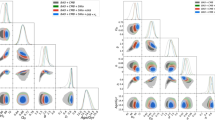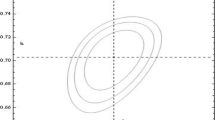Abstract
Dark energy and dark matter problem is one of the most important issues in modern cosmology. There are many candidate models explaining the current observed dark matter and dark energy density parameters. One of the promising models is the interacting dark energy model with holographic principle applied. It was shown that interacting holographic dark energy model in non-flat universe cannot accommodate a transition from the dark energy to the phantom regime and its background cosmological evolution is compatible to current observational data of energy fractions between dark matter and dark energy. However, only a few selected parameters yielded compatible cosmological background evolution. In this article, we want to extend this model to incorporate the current observed Hubble data as red shift. It was shown that the physical parameter most compatible to observed data are \(H_0 \sim 68\) and interaction parameter \(b^2 \sim 0.009\). We have applied a simple numerical regression technique to find out the best interacting model parameters to fit the current observational data. We have shown that the background cosmological evolution is insensitive to interaction strength but the evolution of Hubble constant.




Similar content being viewed by others
References
S. Perlmutter, G. Aldering, G. Goldhaber, R.A. Knop, P. Nugent, P.G. Castro, S. Deustua, S. Fabbro, A. Goobar, D.E. Groom et al., Astrophys. J. 517, 565 (1999). https://doi.org/10.1086/307221
A.G. Riess, A.V. Filippenko, P. Challis, A. Clocchiatti, A. Diercks, P.M. Garnavich, R.L. Gilliland, C.J. Hogan, S. Jha, R.P. Kirshner et al., Astronomical J. 116, 1009 (1998). https://doi.org/10.1086/300499
A.G. Riess, L.-G. Strolger, J. Tonry, S. Casertano, H.C. Ferguson, B. Mobasher, P. Challis, A.V. Filippenko, S. Jha, W. Li et al., Astrophys. J. 607, 665 (2004). https://doi.org/10.1086/383612
P. Astier, J. Guy, N. Regnault, R. Pain, E. Aubourg, D. Balam, S. Basa, R.G. Carlberg, S. Fabbro, D. Fouchez et al., A&A 447, 31 (2006). https://doi.org/10.1051/0004-6361:20054185
M. Tegmark, M.A. Strauss, M.R. Blanton, K. Abazajian, S. Dodelson, H. Sandvik, X. Wang, D.H. Weinberg, I. Zehavi, N.A. Bahcall, et al., Phys. Rev. D 69, 103501 (2004), https://link.aps.org/doi/10.1103/PhysRevD.69.103501
K. Abazajian, J.K. Adelman-McCarthy, M.A. Ageros, S.S. Allam, S.J.A. Kurt, S.F. Anderson, J. Annis, N.A. Bahcall, I.K. Baldry, S. Bastian et al., Astronomical J. 128, 502 (2004). https://doi.org/10.1086/421365
K. Abazajian, J.K. Adelman-McCarthy, M.A. Ageros, S.S. Allam, K.S.J. Anderson, S.F. Anderson, J. Annis, N.A. Bahcall, I.K. Baldry, S. Bastian et al., Astronomical J. 129, 1755 (2005). https://doi.org/10.1086/427544
H.V. Peiris, E. Komatsu, L. Verde, D.N. Spergel, C.L. Bennett, M. Halpern, G. Hinshaw, N. Jarosik, A. Kogut, M. Limon et al., Astrophys. J. Suppl. Ser. 148, 213 (2003). https://doi.org/10.1086/377228
C.L. Bennett, M. Halpern, G. Hinshaw, N. Jarosik, A. Kogut, M. Limon, S.S. Meyer, L. Page, D.N. Spergel, G.S. Tucker et al., Astrophys. J. Suppl. Ser 148, 1 (2003). https://doi.org/10.1086/377253
D.N. Spergel, L. Verde, H.V. Peiris, E. Komatsu, M.R. Nolta, C.L. Bennett, M. Halpern, G. Hinshaw, N. Jarosik, A. Kogut et al., Astrophys. J. Suppl. Ser 148, 175 (2003). https://doi.org/10.1086/377226
D.N. Spergel, R. Bean, O. Dore, M.R. Nolta, C.L. Bennett, J. Dunkley, G. Hinshaw, N. Jarosik, E. Komatsu, L. Page et al., Astrophys. J. Suppl. Ser. 170, 377 (2007). https://doi.org/10.1086/513700
E.J. Copeland, M. Sami, S. Tsujikawa, Int. J. Modern Phys. D 15, 1753 (2006). https://doi.org/10.1142/S021827180600942X
B. Wang, Y. Gong, E. Abdalla, Physics Letters B 624, 141 (2005), ISSN 0370-2693, https://www.sciencedirect.com/science/article/pii/S0370269305010725
S. Wang, Y. Wang, M. Li, Physics Reports 696, 1 (2017), ISSN 0370-1573, holographic Dark Energy, https://www.sciencedirect.com/science/article/pii/S0370157317301564
H. Kim, H.W. Lee, Y.S. Myung, Physics Letters B 632, 605 (2006), ISSN 0370-2693, https://www.sciencedirect.com/science/article/pii/S0370269305017077
K.H. Kim, H.W. Lee, Y.S. Myung, Physics Letters B 648, 107 (2007), ISSN 0370-2693, https://www.sciencedirect.com/science/article/pii/S0370269307003401
H. Tilaver, M. Salti, O. Aydogdu, E. Kangal, Computer Physics Communications 261, 107809 (2021), ISSN 0010-4655, https://www.sciencedirect.com/science/article/pii/S0010465520304033
E.D. Valentino, O. Mena, S. Pan, L. Visinelli, W. Yang, A. Melchiorri, D.F. Mota, A.G. Riess, J. Silk, Class. Quantum Gravity 38, 153001 (2021). https://doi.org/10.1088/1361-6382/ac086d
Z. Ivezic, A.J. Connolly, J.T. VanderPlas, A. Gray, Statistics, Data Mining, and Machine Learning in Astronomy: A Practical Python Guide for the Analysis of Survey Data (Princeton University Press, USA, 2014), ISBN 0691151687
M.S. Berger, H. Shojaei, Phys. Rev. D 73, 083528 (2006), https://link.aps.org/doi/10.1103/PhysRevD.73.083528
I. Bars, L. Krauss, F. Nekoogar, J. Terning, Extra Dimensions in Space and Time, Multiversal Journeys (Springer New York, 2009), ISBN 9780387776385, https://books.google.fr/books?id=fFSMatekilIC
S. Ruder, An overview of gradient descent optimization algorithms (2016), arXiv:1609.04747
J.S. Speagle, MNRAS 493, 3132 (2020). arXiv:1904.02180
Acknowledgements
H.W. Lee and J.C. Kim were supported by the National Research Foundation of Korea (NRF) (No. NRF-2018R1D1A1B05049338). K.Y. Kim was supported by “Regional Innovation Strategy (RIS)” through the National Research Foundation of Korea(NRF) funded by the Ministry of Education (MOE).
Author information
Authors and Affiliations
Corresponding author
Additional information
Publisher's Note
Springer Nature remains neutral with regard to jurisdictional claims in published maps and institutional affiliations.
Rights and permissions
About this article
Cite this article
Kim, J., Lee, H.W. & Kim, K.Y. Finding the best interacting dark energy model with observed data. J. Korean Phys. Soc. 81, 191–197 (2022). https://doi.org/10.1007/s40042-022-00517-8
Received:
Revised:
Accepted:
Published:
Issue Date:
DOI: https://doi.org/10.1007/s40042-022-00517-8




